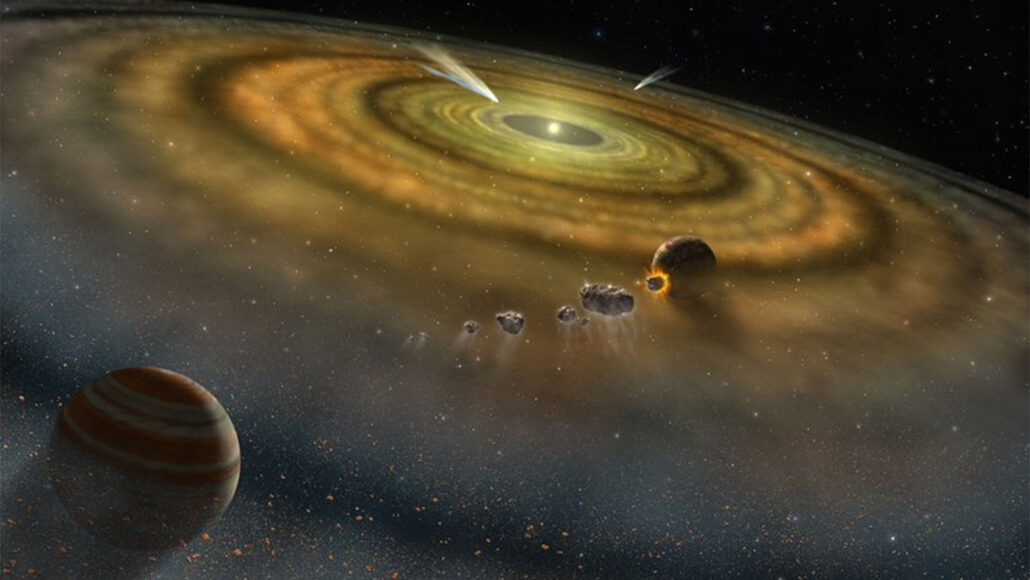A long-ago reshuffling of the giant planets in our solar system may have been instrumental in giving Earth its moon.
For decades, planetary scientists have hypothesized that Jupiter, Saturn, Uranus and Neptune were born much closer to the sun and that gravitational interactions among those planets jolted them into their contemporary trajectories (SN: 5/10/22). But the timing of that “giant planet orbital instability” has been tricky to nail down.
Now, an analysis of meteorite data suggests that the instability took place between 60 million and 100 million years after the solar system started forming, planetary scientist Alessandro Morbidelli reported October 5 in San Antonio at a meeting of the American Astronomical Society’s Division for Planetary Sciences. That timing also roughly coincides with when Earth’s moon is thought to have formed in the wake of a Mars-sized planet running into our own.
The instability of the giant planets “is related to a complete reshaping of the solar system, the formation of the cometary reservoirs, the sculpting of the asteroid belt,” says Morbidelli, of the Observatoire de la Côte d’Azur in Nice, France. “Understanding when it occurred means fixing a milestone in the history of the solar system.”
The giant planet migration, first proposed by Morbidelli and colleagues in 2005, is a widely accepted hypothesis for explaining much about the solar system. In particular, the giant planets travel along slightly elongated orbits that are askew to one another. But observations of other planetary systems and computer simulations of planet formation suggest that giant planets, in general, form on closer-in orbits that are circular and coplanar. Using simulations, Morbidelli and others showed that if the giant planets in our solar system formed like that, they wouldn’t stay that way. Gravitational interactions would eventually knock the planets into the orbits they have today.
At first, the team thought this instability occurred about 600 million years after the birth of the solar system. That timing meant the migration of the giant planets could also explain an apparent asteroid bombardment of the terrestrial planets — Mercury, Venus, Earth and Mars — as evidenced by craters on the moon and lunar rocks brought back by Apollo astronauts. More recent work, however, has cast doubt on the reality of this “lunar cataclysm.”
Now, Morbidelli suspects the orbital instability came a lot earlier. His reasoning starts with a rare type of meteorite called EL enstatite chondrites.
The mix of elements in these meteorites suggests they must be the remnants of a large rocky body, a few hundred kilometers across, born near the terrestrial planets in the dusty disk that once swirled around our sun.
Then, in 2022, Morbidelli and colleagues showed that any of these enstatites that land on Earth today must come from a collection of bits and pieces in the asteroid belt between Mars and Jupiter. Those bits all broke off Athor, one of the many asteroids there, after it collided long ago with some other object in the belt. Altogether, that family of material adds up to an asteroid roughly 60 kilometers across — much smaller than the one thought to have birthed the enstatites in the first place. That means Athor must be only one piece of that larger rocky body, left over from a collision that destroyed it much closer to the sun.
“The question is, which dynamical mechanism can allow the implantation of Athor in the asteroid belt?” Morbidelli said at the meeting.
He tried computer simulations of several possibilities, but so far, only the giant planet instability seems capable of sending Athor to a stable orbit in the asteroid belt.
This couldn’t have happened earlier than 60 million years after the birth of the solar system, Morbidelli said. Radioactive elements in the enstatite chondrites indicate their parent body was slowly cooling until then, which means it was still large. It hadn’t yet collided with one of the many other planetesimals stirred around by the forming terrestrial planets.
On the other hand, simulations suggest the instability can’t have occurred later than about 100 million years after the solar system began. A study in 2018 concluded that if the giant planets migrated later, a pair of asteroids dubbed Patroclus-Menoetius, trailing Jupiter around the sun while orbiting each other, would have been pulled apart.
That 60-million- to 100-million-year window makes the instability a prime suspect in the diversion of a hypothesized planet that hit Earth, creating the moon (SN: 3/15/23). The timing “seems right,” says Matthew Clement, an astrophysicist at the Johns Hopkins Applied Physics Laboratory in Laurel, Md. “Lots of things were happening in the solar system’s early history. However, dynamically speaking, we don’t have a whole lot of reason to believe that things changed much after the moon-forming impact.”
But he cautions that Morbidelli’s estimate is based on “one data point, of the breakup of one asteroid, pieces of which serendipitously happened to get to Earth.”
Still, “it’s nice that [the new result] is actually based on some real data, even if it’s indirectly, rather than just computer models,” says planetary scientist John Chambers. He has questions, though. “They suggest this happened when the formation of the terrestrial planets was more or less complete, apart maybe from the giant impact that formed the moon,” says Chambers, of the Carnegie Institution for Science in Washington, D.C. “But then there’s a good chance it would have messed up the orbits of the terrestrial planets and possibly led to some of them colliding,” which the current lineup of planets suggests did not happen.
Both Chambers and Matthews have worked on scenarios in which the orbital instability occurred even earlier, just a few million years after the solar system began. That earlier time for the instability would help explain one of the outstanding riddles of the solar system: the relatively small size of Mars compared with Earth and Venus. That’s because the instability would have removed many objects from near the orbit of Mars before it could grow to the size of Earth or larger. The new result from Morbidelli’s team seems to exclude that solution.
“I’m prepared to rely on the evidence,” Chambers says. But he isn’t convinced yet because many facets of the solar system’s present structure must be reconciled with any date for the giant planet instability.
Clement agrees. “There’s problems if the instability happened at 500 million years. There’s still problems that we have to resolve if it happened when they say it happened,” he says. “And there’s still problems if it happened immediately after the planets formed, in the first few million years. This story is not done being told yet.”






